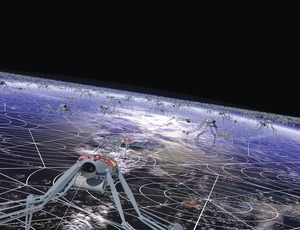
Illustration by Jerry Flynn
"Sorry to wake you."
Sam groggily opened his eyes. "What is it, No. 1?"
"An issue has arisen that requires your attention."
Ugh. "No problem. I've been asleep," Sam grumpily checked the chrono, "for three hours. Report."
"Sir, sleep deprivation can adversely affect brain function. Shall I call back in two hours?"
AI sarcasm. Ugh. "No, I'm awake. Give me a minute, and I'll be in ComDeck."
Sam bounded the short distance to the shack's command deck. He quickly scanned vitals. Everything looked nominal. "So, what's the issue that required you to wake me?"
"Two hundred and twenty-eight seconds ago, an unexplained vibration anomaly occurred at Polygon Node Two, indicating a possible space-debris impact."
That's not good, Sam thought. "That's close by the shack. Which spiderbot formation is closest to the junction in question?"
"Spider Formation E-1022."
"Status report."
![]() "Spider Formation E-1022 is processing thread at a nominal rate. At their current production speed, they should complete Fractal Shade 10K5 in 135 hours." Of the 8,192 spiders in that formation, 81 are consuming approximately 102% normal power. The spiders are weaving cotton candy at the rate of 3,000 cubic meters per hour. Hold … "
"Spider Formation E-1022 is processing thread at a nominal rate. At their current production speed, they should complete Fractal Shade 10K5 in 135 hours." Of the 8,192 spiders in that formation, 81 are consuming approximately 102% normal power. The spiders are weaving cotton candy at the rate of 3,000 cubic meters per hour. Hold … "
"IMPACT ALERT."
Before Sam could react he felt a woof of air and a loud crack as the starboard wall of the shack came flying toward him. It felt like someone just hit him with a wall of bricks—or iron, in this case. Sam found himself bouncing off the flying wall and barely snatched a hand rail to keep from bouncing off the port wall.
"One of the shack's anchor cables just snapped!" Sam yelled.
"Negative. All cables are intact. However, the port-side pair have gone slack."
Looking out the port side of the transparent hemisphere that made up the observation dome, Sam could see the forward cable take on a snake-like track—a good indication something was very wrong. And that was roughly the direction toward Node Two.
Something very heavy just impacted the structure, Sam thought, maybe irreparably damaging the thread. "Thread" was the name given to the most brilliant material ever developed by humankind: Astroid Glass. Large mirrors are employed to feed sunlight to a solar furnace that is used to extract the raw materials from an asteroid parked in lunar orbit for the unimaginably high-strength-glass manufacturing process. Iron is collected as a by-product and is used to build spacecraft and other structures on the construction site.
And what a construction site! Sam thought.
The Short-Term Global Climate Stabilization Platform—"Stigs" for short—is a project born out of the urgent need to regulate Earth's atmospheric temperature. Back in the early part of the century, climatologists had predicted, correctly, that even if humanity had immediately stopped pumping greenhouse gases into the atmosphere, climate temperatures would still rise to the point where bad things would happen to the entire ecosphere. That's when Stigs went from a wacky idea to humanity's No. 1 priority construction project, the largest by several magnitudes ever attempted.
Picture a spinning structure encircling the Earth from 60° north of the equator to 60° south, orbiting approximately 640 kilometers above the surface. The structure is constructed as a polygonal array of structural beams made of huge bundles of thread, each approximately 50 kilometers in length. Each polygon is filled with a sheet of spun-thread filaments reminiscent of cotton candy. That's Stigs, the largest, most ambitious construction project ever conceived—and it's all constructed from glass.
The concept is simple: The cotton-candy blocks a tiny percentage of sunlight, and the atmosphere drops the requisite number of degrees to offset the rise in temperature from the existing greenhouse gases. Once the gases dissipate and the temperatures begin to drop, engineers can reverse the process by removing the shade.
But back to the problem at hand: the unexplained "bump in the night."
"Bring up the site plan," Sam commanded. In the observation dome, a 3D hologram appeared, showing Sam's assigned workspace: one polygon. Small blue dots that were spread out over the slightly bowed plane of the polygon identified clusters of the bots spinning the cotton candy. The scale of the work site made it impossible to see individual units. Yellow lines that appeared to be slightly curved defined polygon structure. The cotton candy appeared like gray smoke within the polygon. Sam noticed something.
"Zoom in on Formation E-1022."
The image dissolved into a close-up of the spiderbots spinning the cotton candy between the thicker strands that anchored the gossamer material to the polygonal main members. Sam could just make out the shack on the edge of the view.
"Notice anything odd about the cotton candy near the node?"
"No, sir. It appears chaotically regular, as one would expect of a randomized fractal pattern."
"Wrong. There's a shock pattern in the material just near the node. I can just barely make it out, but it's there." A thread tangle at an intersection node could be bad news. It meant potential damage to the polygon structure.
"Prep the shack. We are going for a ride."
Sam could feel the release of the anchor lines and the initial thrust impulse on the shack, which now was undocked and transformed into a spacecraft. No. 1 piloted it toward the node.
A few hours later, as they approached, Sam could clearly see the node as a thicker part of the structure at the vertex of the adjacent polygons. But there was something else, something not "glassy." Something big and blocky was lodged in the web, and it was close to the node!
"Do you see it?"
"Yes, sir, it appears to be a large satellite lodged in the structure near the node. I do not recognize its configuration."
It was no ordinary piece of space junk. In the artificial light from the shack it was easy to see the large hulk of a ship or something. On the side of the cylindrical shape, Sam could just make out the letters CCC and part of a P.
"I'll be a … " Sam exclaimed. "It must be an undocumented deep-orbit probe sent up by the Soviets back in the 1960s. And that," Sam pointed, "is the nuclear-power supply. Look for a plutonium signature in the radiation."
"Plutonium detected."
"Leakage?"
"None, sir. The containment capsule is intact."
They don't make them like that anymore, Sam thought.
"Okay, contact Lunar Control, fill them in. No. 1, can we remove it using the manipulators?"
"One moment."
A large cloud of 3D display points appeared momentarily in the observation dome. This resolved into a 3D image of the probe and the damaged polygon structure surrounding it. As No. 1 performed a structural analysis of the impact site, the colors began to appear: green (stet), blue (acceptable), some yellow (needs addressing) but no red (structural failure)—a good sign.
No. 1 concluded, "It can be removed with care."
"Careful is my middle name. Break out the waldos and bring us in close."
The mechanical arms moved in perfect sync with his own hand motions. Using a cutting shear attached to the waldo's hand, Sam severed the tangled thread from around the wrecked probe. After some time the probe was nearly clear.
Sam found suitable anchor points and then clamped onto the probe. "Back her up," he ordered. Right on cue, the shack shuddered as the forward-facing thrusters fired. After a few tense seconds, the probe broke free.
"OK, let's assess the damage to the node and surrounding structure." A different 3D image appeared in front of Sam, and another round of structural analysis began. Now the structure showed mostly blues and greens.
"It looks good to me."
"Yes, sir. The probe impacted at an oblique angle on the strongest part of the main structure. Had it been traveling at a higher velocity or directly hit the node, the damage would have been much more extensive."
"That's an understatement," Sam thought with a sigh of relief. "About time we got a break. We'll need to repair the damage as soon as possible. Start assembling a spiderbot repair team and put in a priority request for the structural thread we'll need."
"Right away, sir."
"As for the recovered probe, request Lunar Control send out a barge to pick up the Soviet relic. I'm sure the museum at Luna City would be interested in it."
With that out of the way, Sam yawned and stretched once and then bounded for the sleeping quarters. "If it is OK with you, I'm going back to bed. Wake me if another probe comes our way."
As Sam zipped the sleeping net closed, his thoughts turned toward the future. His eldest son, Sam Jr., was already in training as part of Stig's maintenance crew for the next stage of the project, set to begin in about five years. Perhaps, Sam thought as he drifted into sleep, his granddaughter or grandson might be on the team that retires old Stig when it's no longer needed. Three generations to save the world.

To see all of the Construction Science Fiction stories, click here.

Post a comment to this article
Report Abusive Comment